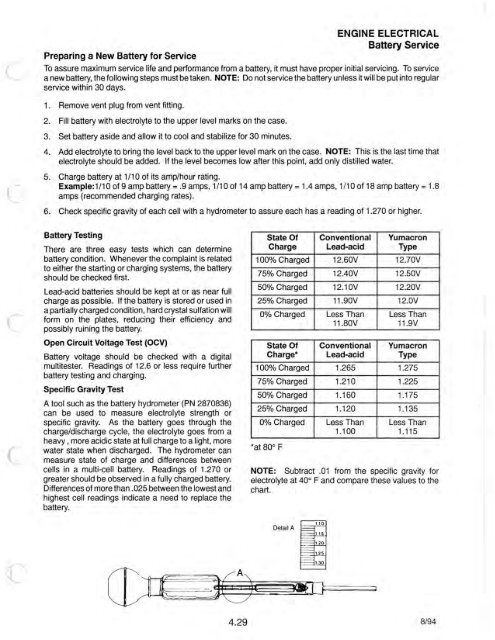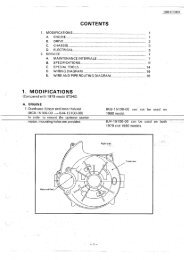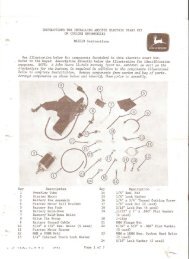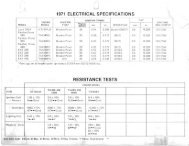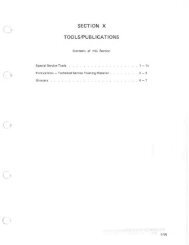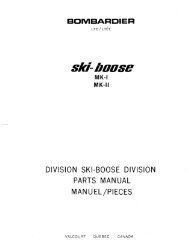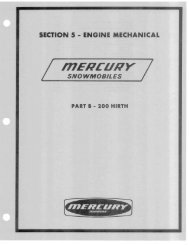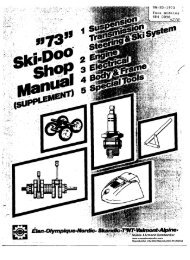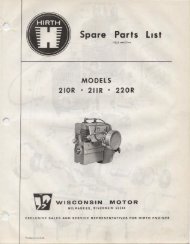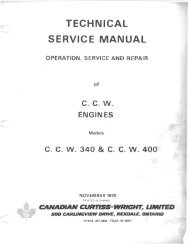You also want an ePaper? Increase the reach of your titles
YUMPU automatically turns print PDFs into web optimized ePapers that Google loves.
(Preparing a New Battery for ServiceENGINE ELECTRICALBattery ServiceTo assure maximum service life and performance from a battery, it must have proper initial servicing. To servicea new battery, the following steps must be taken. NOTE: Do not service the battery unless it will be put into regularservice within 30 days.1 . Remove vent plug from vent fitting.2. Fill battery with electrolyte to the upper level marks on the case.3. Set battery aside and allow it to cool and stabilize for 30 minutes.4. Add electrolyte to bring the level back to the upper level mark on the case. NOTE: This is the last time thatelectrolyte should be added. If the level becomes low after this point, add only distilled water.c5. Charge battery at 1/10 of its amp/hour rating.Example: 1 /1 0 of 9 amp battery = .9 amps, 1/10 of 14 amp battery = 1.4 amps, 1/10 of 18 amp battery = 1.8amps (recommended charging rates).6. Check specific gravity of each cell with a hydrometer to assure each has a reading of 1.270 or higher.cBattery TestingThere are three easy tests which can determinebattery condition. Whenever the complaint is relatedto either the starting or charging systems, the batteryshould be checked first.Lead-acid batteries should be kept at or as near fullcharge as possible. If the battery is stored or used ina partially charged condition, hard crystal sulfation willform on the plates, reducing their efficiency andpossibly ruining the battery.Open Circuit Voltage Test (OCV)Battery voltage should be checked with a digitalmultitester. Readings of 12.6 or less require furtherbattery testing and charging.Specific Gravity TestA tool such as the battery hydrometer (PN 2870836)can be used to measure electrolyte strength orspecific gravity. As the battery goes through thecharge/discharge cycle, the electrolyte goes from aheavy, more acidic state at full charge to a light, morewater state when discharged. The hydrometer canmeasure state of charge and differences betweencells in a multi-cell battery. Readings of 1.270 orgreater should be observed in a fully charged battery.Differences of more than .025 between the lowest andhighest cell readings indicate a need to replace thebattery . .State Of Conventional YumacronCharge Lead-acid Type100% Charged 12.60V 12.70V75% Charged 12.40V 12.50V50% Charged , 12.10V 12.20V25% Charged 11.90V 12.0V0% Charged Less Than Less Than11.80V 11 .9VState Of Conventional YumacronCharge* Lead-acid Type1 00% Charged 1.265 1.27575% Charged 1.210 1.22550% Charged 1.160 1.17525% Charged 1.120 1.1350% Charged Less Than Less Than1.1 00 1.115*at 80° FNOTE: Subtract .01 from the specific gravity forelectrolyte at 40° F and compare these values to thechart.4.298/94


